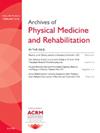Housing and Disability: Social Determinants of Health Utilizing a National Geospatial Analysis 8264
IF 3.6
2区 医学
Q1 REHABILITATION
Archives of physical medicine and rehabilitation
Pub Date : 2025-04-01
DOI:10.1016/j.apmr.2025.01.023
引用次数: 0
Abstract
Objectives
To demonstrate the macro dynamics of housing and disablement by comparing pressures on a broad range of issues related to housing and disablement across states.
Design
Examination of US Census Data, American Community Survey, using statistical hypothesis testing.
Setting
Data for this nationally representative study are from the American Community Survey, with state-level aggregated measures from the Annual Disability Statistics Compendium.
Participants
Approximately 3,500,000 US adults via the American Community Survey with state-level aggregated measures from the Annual Disability Statistics Compendium.
Interventions
No interventions, this is a natural experiment.
Main Outcome Measures
Housing issues are measured at a state-level percent of community living adults by disability status across 6 housing metrics: lacks a complete kitchen, lacks complete plumbing, overcrowded home environment, housing cost burden, poor housing, and old housing. Housing type is measured by the state-level percent of US community living adults living in houses, apartments, and mobile homes.
Results
Disabled adults are more likely to live in old housing (t=−16.777, P<.001) but less likely to experience all other housing issues: lacks a complete kitchen (t=10.3181, P<.001), lacks complete plumbing (t=5.2579, P<.001), high housing cost burden (t=30.6175, P<.001), and poor housing (t=27.0892, P<.001). The percent of housing with incomplete plumbing per state is strongly positively associated with housing with incomplete kitchens per state (r=0.802, P<.001). States with higher rates of overcrowding have higher housing cost burden (r=0.439, P=.002) and higher rates of poor housing (r=0.496, P<.001). States with high housing cost burden have higher rates of poor housing (r=0.878, P<.001). States that have a high housing cost burden have lower rates of people living in older housing (r=−0.329, P=.017). States with a high rate of poor housing also have a high rate of overcrowded homes (r=0.496, P<.001) and high rate of housing cost burden (r=0.878, P<.001), however, they have lower rates of old housing (r=−0.323, P=.019). States with high rates of old housing have lower housing cost burden (r=−0.329, P=.017) and lower rates of poor housing (r=−0.323, P=.019).
Conclusions
Housing issues disproportionately affect disabled adults in the United States. We argue that the multidimensional nature of housing, through cost burdens, upkeep and maintenance, renting versus ownership, and types of housing prevalent in the United States, creates a paradox of livability versus affordability for disabled adults. In rehabilitation, return to home is substantively dependent on the ability to return to a home. Case Managers and Occupational Therapists should be keenly aware of things findings to help in GAS and case management.
Disclosures
none.
住房和残疾:利用国家地理空间分析的健康的社会决定因素8264
目的通过比较各州与住房和残疾有关的广泛问题上的压力,展示住房和残疾的宏观动态。美国人口普查数据的设计检验,美国社区调查,使用统计假设检验。这项具有全国代表性的研究的数据来自美国社区调查,以及来自年度残疾统计汇编的州一级汇总数据。参与者:大约350万美国成年人通过美国社区调查和年度残疾统计汇编的州一级汇总措施。干预没有干预,这是一个自然实验。住房问题是通过六个住房指标(缺乏完整的厨房、缺乏完整的管道、过度拥挤的家庭环境、住房成本负担、贫困的住房和旧的住房),以州一级的社区生活成年人的残疾状况来衡量的。住房类型是由居住在房屋、公寓和移动房屋中的美国社区成年人在州一级的百分比来衡量的。结果残障成年人居住在老旧住房的可能性较大(t= - 16.777, P<.001),但遇到其他住房问题的可能性较小:缺乏完整的厨房(t=10.3181, P<.001),缺乏完整的管道(t=5.2579, P<.001),住房成本负担高(t=30.6175, P<.001),住房条件差(t=27.0892, P<.001)。每个州管道不完整的住房百分比与每个州厨房不完整的住房百分比呈正相关(r=0.802, P<.001)。过度拥挤率较高的州的住房成本负担较高(r=0.439, P= 0.002),住房质量差的比率较高(r=0.496, P= 0.001)。住房成本负担高的州,不良住房率较高(r=0.878, P<.001)。住房成本负担高的州,居住在旧住房中的人口比例较低(r= - 0.329, P= 0.017)。贫困住房率高的州,住房过度拥挤率也高(r=0.496, P= 0.001),住房成本负担率也高(r=0.878, P= 0.001),但旧住房率较低(r= - 0.323, P= 0.019)。旧住房率高的州住房成本负担较低(r= - 0.329, P= 0.017),劣质住房率较低(r= - 0.323, P= 0.019)。住房问题不成比例地影响着美国的残疾成年人。我们认为,住房的多维性,通过成本负担,维护和维护,租赁与所有权,以及美国普遍存在的住房类型,为残疾成年人创造了宜居性与可负担性的悖论。在康复方面,能否回家在很大程度上取决于能否回家。病例管理人员和职业治疗师应该敏锐地意识到有助于GAS和病例管理的发现。
本文章由计算机程序翻译,如有差异,请以英文原文为准。
求助全文
约1分钟内获得全文
求助全文
来源期刊
CiteScore
6.20
自引率
4.70%
发文量
495
审稿时长
38 days
期刊介绍:
The Archives of Physical Medicine and Rehabilitation publishes original, peer-reviewed research and clinical reports on important trends and developments in physical medicine and rehabilitation and related fields. This international journal brings researchers and clinicians authoritative information on the therapeutic utilization of physical, behavioral and pharmaceutical agents in providing comprehensive care for individuals with chronic illness and disabilities.
Archives began publication in 1920, publishes monthly, and is the official journal of the American Congress of Rehabilitation Medicine. Its papers are cited more often than any other rehabilitation journal.

 求助内容:
求助内容: 应助结果提醒方式:
应助结果提醒方式:


